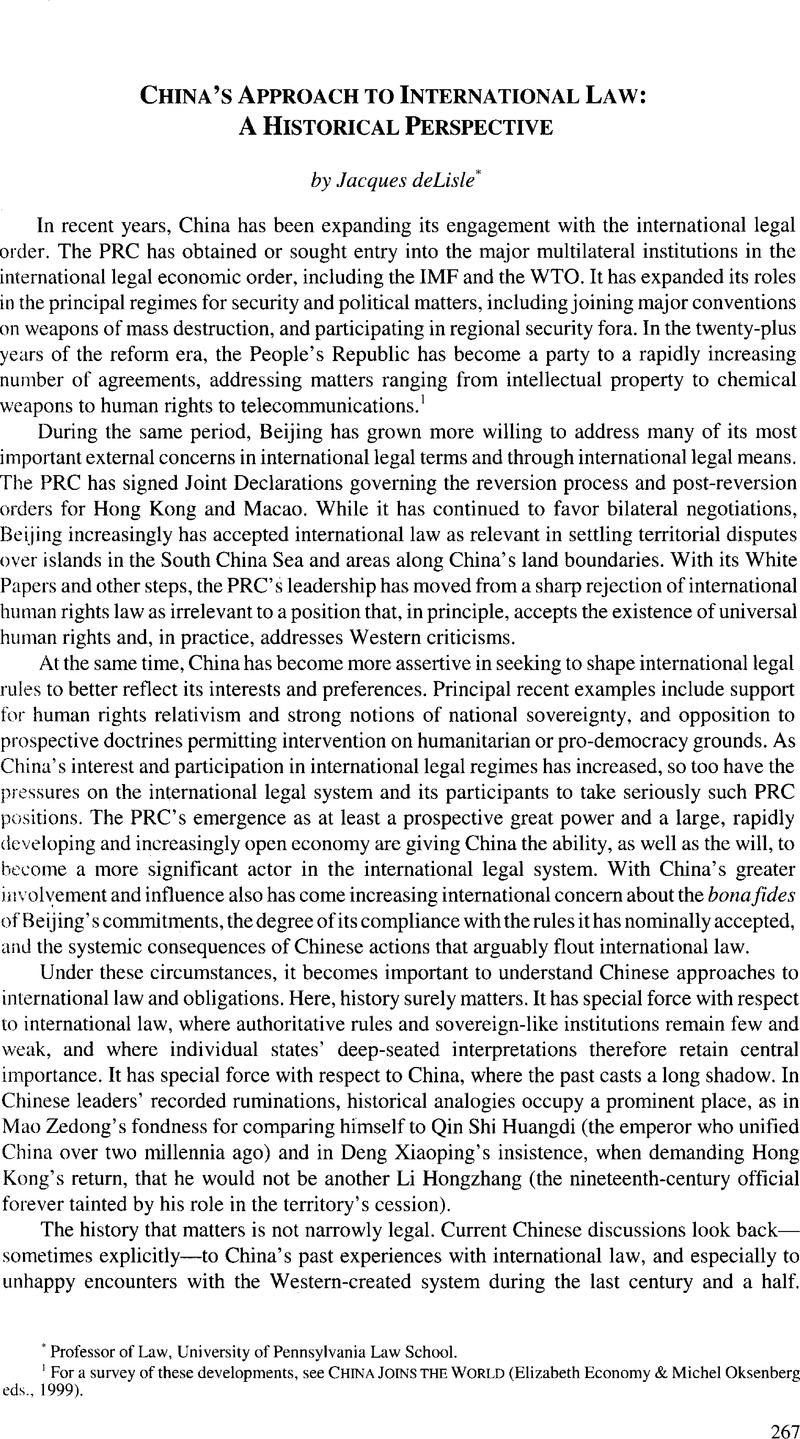Article contents
China’s Approach to International Law: A Historical Perspective
Published online by Cambridge University Press: 28 February 2017
Abstract

- Type
- Meeting Report
- Information
- Copyright
- Copyright © American Society of International Law 2000
References
1 For a survey of these developments, see China Joins the World (Elizabeth Economy & Michel Oksenberg eds., 1999).
2 E. H. Carr, The Twenty Years’ Crisis (2d ed., 1946); Neorealism and Neoliberalism: The Contemporary Debate (David A. Baldwin ed., 1993); Thucydides, The Peloponnesian Wars (Rex Warner trans., 1972); New Thinking in International Relations Theory (Michael W. Doyle & G. John Ikenberry eds., 1997); Condoleezza Rice, Promoting the National Interest, FOREIGN AFF. 45 (Jan.-Feb. 2000); Stephen M. Walt, Two Cheers for Clinton’s Foreign Policy, Foreign Aff. 63 (Mar.-Apr. 2000).
3 Kennethn. Waltz, Man, The State and War: Atheoretical Analysis (1959); Doyle, Michael W., Kant, Liberal Legacies and Foreign Affairs, 12 Phil. & Pub. Aff. 205–235, 323-353 (1983)Google Scholar; Gourevitch, Peter A., The Second Image Reversed: International Sources of Domestic Politics, 32 Int’l Org. 881 (1978)CrossRefGoogle Scholar; Slaughter, Anne-Marie, International Law in a World of Liberal States, 6 Eur. J. Int’l L. 503 (1995)CrossRefGoogle Scholar; Walt, supra note 2; Rice, supra note 2.
4 The international relations dimension emerged most fully in the Han dynasty debate recorded in the yantielun. See Huan Kuan, Discourses on Salt and Iron (Esson M. Gale trans., 1931). On this and all later periods in China’s approaches to international law, see Tieya, Wang, International Law in China: Historical and Contemporary Perspectives, 221 Rec. Des Cours 195–356 (1990)Google Scholar. On the broader Confucian-Legalist debate, see 1 Sources of Chinese Tradition (William T. deBary et al. eds., 1960).
5 See China Among Equals: The Middle Kingdom and Its Neighbors (Morris Rossabi ed., 1982); The Chinese World Order: Traditional China’s Foreign Relations (John K. Fairbank ed., 1968); Markmancall, China at the Center: 300 Years of Foreign Policy (1984).
6 See China’s Response to the West: A Documentary History (Ssu-yu Teng & John K. Fairbank eds., 1963); 2 Sources of Chinese Tradition (William T. deBary et al eds., 1960). Classic scholarly treatments of later parts of the era include Wesley R.Fishel, The End of Extraterritoriality in China (1972); Chow Tse-Tsung, The May Fourth Movement (1960); Wang, supra note 4.
7 Explicit discussion of the Republican period is omitted. Nationalist approaches began as some of the more radical responses to the West and were in large part incorporated in early PRC approaches.
8 See Law in Chinese Foreign Policy (Shao-chuan Leng & Hungdah Chiu eds., 1972); People’s China and International Law (Jerome A. Cohen & Hungdah Chiu eds., 1974); Zhou Gengsheng, Guoiifa (1981).
9 Good surveys of post-Mao China’s engagement with the international order include China Joins the World, supra note 1. On law specifically, see Guojifa Gailun (Wei Min et al. eds., 1986); Guojifa (Wang Tieya & Wei Min eds.. 1981); Chiu, Hungdah, Chinese Attitudes Toward International Law in the Post-Mao Era, 21 Int’l Law. 1127 (1987)Google Scholar: Feinerman, James V., Chinese Participation in the International Legal Order, 141 China Q. 186 (1995)CrossRefGoogle Scholar; Kim, Samuel S., The Development of International Law in Post-Mao China, 1 J. Chinese L. 117 (1987)Google Scholar.
- 8
- Cited by




